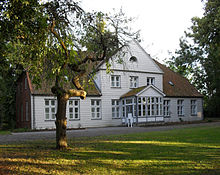Gut Strecknitz
The Strecknitz estate has belonged to the Hanseatic City of Lübeck since the Middle Ages and has been gradually settled since the beginning of the 20th century. It is named after the Strecknitz river , which runs along its southern border and, coming from Krummesse , has been part of the Lübeck Landwehr since 1300 .
history
The first documentary mention in 1248 shows the Strecknitz estate as a municipal property, which has been given to different tenants again and again from at least 1339 onwards. The leases of such companies were then left to the otherwise voluntary councilors and mayors as benefices . So the usufruct at Gut Strecknitz was entitled to one of the four simultaneous mayors for life. The mayors Heinrich Plönnies , Johann Lüdinghusen , Jakob Bording , Heinrich Wedemhof and Otto Brokes were among the beneficiaries . In 1662 the mayor Gotthard von Höveln leased the estate from the city, which was financially badly damaged by the burdens of the Thirty Years' War, with which he soon fell out. During this time, between the flourishing manor economy in Holstein and the regulated guilds in the cities, the most serious dispute arose over the Bönhasen, i.e. the free competition of handicrafts that were not subject to regulation, which were performed in the vicinity of the manors and offered to townspeople at correspondingly lower prices. Höveln gave up the lease of Strecknitz in 1668, one year before his big scandal with Lübeck. The city first leased the business and then sold it in 1685 to the merchant Daniel von Melle for only 28,900 Courantmarks . The estate was soon sold on at a profit and to, as they say in Holstein and Mecklenburg , Walzengut , i.e. a company that was often handled and therefore always on the roll . However, the management continued mostly by tenants.

In 1807 the estate was acquired by August Christian Julius Lüdemann, who also built the nine-axle mansion with a crooked hip roof around 1810 at the end of the avenue of Peter-Monnik-Weg , which has been used by the Medical Laser Center since 1986 . After several changes of ownership, the Heiligen-Geist-Hospital Foundation acquired the property in 1895 for 370,000 gold marks .
Resettlement in the 20th century
In 1909 the foundation sold the Lübeck state from Gut Strecknitz a part of about 20 hectares for the construction of the new sanatorium Strecknitz , which existed until the Second World War. Today the buildings are used by the University of Lübeck .
In 1916 Heinrich Erasmi took over the management of the remaining Strecknitz goods, who grew vegetables there for his Charlotte Erasmi canning factory . This made it necessary to build a reaper's barracks on the farm yard. The Heiligen-Geist-Hospital Foundation sold the remnants to the Lübeck state in 1929. This measure is to be seen in connection with other similar measures in preparation for the foreseeable loss of Lübeck's statehood. The Lübeckers sold the state property outside the municipal area to the wealthy foundations of the Heiligen-Geist-Hospital and the Johanniskloster, controlled by the city, as legal entities, which in turn sold parts of their property within the city limits of Lübeck not to the threatened Lübeck state , but rather sold to the existing municipality of Lübeck , i.e. the municipality. This order Prussia expropriation Lübeck land ownership in the countryside, especially in the Lübeck enclaves to complicate or frustrate. The sanatorium now took over the management of the farm with its patients. For this purpose, the area was completely fenced in over a length of over six kilometers. The management was stopped again in the 1930s. During the war, the area became the East Hospital of the Hanseatic City of Lübeck. The Lübeck University of Applied Sciences was also built on the grounds of the Strecknitz estate. For the time being the last and probably final measure of the settlement and development of building land was the not yet completed construction of the new Lübeck university district .
literature
- Hubertus Neuschäffer: Manor houses and mansions in and around Lübeck: a manual . Wachholtz, Neumünster 1988, ISBN 3-529-02691-3 , pp. 299-310 .
Sources and Notes
- ↑ Craftsman language
- ↑ Named after a Lübeck council clerk of the 15th century who campaigned strongly in 1479 for the establishment of a madhouse at the inner mill gate .
- ↑ Lübeck Medical Laser Center
- ↑ see: Greater Hamburg Law of 1937
Coordinates: 53 ° 49 ′ 58 ″ N , 10 ° 42 ′ 41 ″ E

